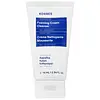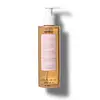What's inside
What's inside
 Key Ingredients
Key Ingredients

 Benefits
Benefits

 Concerns
Concerns

 Ingredients Side-by-side
Ingredients Side-by-side

Water
Skin ConditioningSodium Cocoyl Isethionate
CleansingCoco-Betaine
CleansingCetearyl Alcohol
EmollientDisodium Lauryl Sulfosuccinate
CleansingZea Mays Starch
AbsorbentGlycerin
HumectantCocamidopropyl Betaine
CleansingSodium Chloride
MaskingMagnesium Aluminum Silicate
AbsorbentSodium Methyl Cocoyl Taurate
CleansingGlyceryl Laurate
EmollientSclerotium Gum
Emulsion StabilisingAlpha-Glucan Oligosaccharide
CleansingAmaranthus Caudatus Seed Extract
Skin ConditioningChlorella Vulgaris Extract
Skin ConditioningCitric Acid
BufferingHydrogenated Castor Oil
EmollientHydrolyzed Rice Protein
Skin ConditioningLactic Acid
BufferingLactis Proteinum
Skin ConditioningLactobacillus
Skin ConditioningLactose
HumectantLaminaria Digitata Extract
Skin ProtectingLonicera Caprifolium Flower Extract
PerfumingLonicera Japonica Flower Extract
Skin ConditioningMaltodextrin
AbsorbentMaris Aqua
HumectantPentylene Glycol
Skin ConditioningPhenethyl Alcohol
MaskingPolymnia Sonchifolia Root Juice
Skin ConditioningSaccharide Isomerate
HumectantSodium Cocoyl Alaninate
Sodium Phytate
Titanium Dioxide
Cosmetic ColorantYogurt
Skin ProtectingYogurt Powder
Phenoxyethanol
PreservativeSodium Benzoate
MaskingParfum
MaskingWater, Sodium Cocoyl Isethionate, Coco-Betaine, Cetearyl Alcohol, Disodium Lauryl Sulfosuccinate, Zea Mays Starch, Glycerin, Cocamidopropyl Betaine, Sodium Chloride, Magnesium Aluminum Silicate, Sodium Methyl Cocoyl Taurate, Glyceryl Laurate, Sclerotium Gum, Alpha-Glucan Oligosaccharide, Amaranthus Caudatus Seed Extract, Chlorella Vulgaris Extract, Citric Acid, Hydrogenated Castor Oil, Hydrolyzed Rice Protein, Lactic Acid, Lactis Proteinum, Lactobacillus, Lactose, Laminaria Digitata Extract, Lonicera Caprifolium Flower Extract, Lonicera Japonica Flower Extract, Maltodextrin, Maris Aqua, Pentylene Glycol, Phenethyl Alcohol, Polymnia Sonchifolia Root Juice, Saccharide Isomerate, Sodium Cocoyl Alaninate, Sodium Phytate, Titanium Dioxide, Yogurt, Yogurt Powder, Phenoxyethanol, Sodium Benzoate, Parfum
Water
Skin ConditioningSodium Coceth Sulfate
CleansingCocamidopropyl Hydroxysultaine
CleansingSodium Lauryl Glucose Carboxylate
CleansingLauryl Glucoside
CleansingSalix Alba Bark Extract
AstringentPEG-120 Methyl Glucose Dioleate
EmulsifyingSodium Chloride
MaskingGlycerin
HumectantAloe Barbadensis Leaf Juice Powder
Skin ConditioningCamellia Sinensis Leaf Extract
AntimicrobialDecyl Glucoside
CleansingDisodium Cocoamphodiacetate
CleansingDisodium Cocoyl Glutamate
CleansingLactic Acid
BufferingLevulinic Acid
PerfumingLonicera Caprifolium Flower Extract
PerfumingLonicera Japonica Flower Extract
Skin ConditioningParfum
MaskingPunica Granatum Fruit Extract
AntioxidantSalicylic Acid
MaskingSodium Cocoyl Glutamate
CleansingSodium Levulinate
Skin ConditioningTetrasodium Glutamate Diacetate
Phenoxyethanol
PreservativePotassium Sorbate
PreservativeSodium Benzoate
MaskingSorbic Acid
PreservativeWater, Sodium Coceth Sulfate, Cocamidopropyl Hydroxysultaine, Sodium Lauryl Glucose Carboxylate, Lauryl Glucoside, Salix Alba Bark Extract, PEG-120 Methyl Glucose Dioleate, Sodium Chloride, Glycerin, Aloe Barbadensis Leaf Juice Powder, Camellia Sinensis Leaf Extract, Decyl Glucoside, Disodium Cocoamphodiacetate, Disodium Cocoyl Glutamate, Lactic Acid, Levulinic Acid, Lonicera Caprifolium Flower Extract, Lonicera Japonica Flower Extract, Parfum, Punica Granatum Fruit Extract, Salicylic Acid, Sodium Cocoyl Glutamate, Sodium Levulinate, Tetrasodium Glutamate Diacetate, Phenoxyethanol, Potassium Sorbate, Sodium Benzoate, Sorbic Acid
 Reviews
Reviews

Ingredients Explained
These ingredients are found in both products.
Ingredients higher up in an ingredient list are typically present in a larger amount.
Glycerin is already naturally found in your skin. It helps moisturize and protect your skin.
A study from 2016 found glycerin to be more effective as a humectant than AHAs and hyaluronic acid.
As a humectant, it helps the skin stay hydrated by pulling moisture to your skin. The low molecular weight of glycerin allows it to pull moisture into the deeper layers of your skin.
Hydrated skin improves your skin barrier; Your skin barrier helps protect against irritants and bacteria.
Glycerin has also been found to have antimicrobial and antiviral properties. Due to these properties, glycerin is often used in wound and burn treatments.
In cosmetics, glycerin is usually derived from plants such as soybean or palm. However, it can also be sourced from animals, such as tallow or animal fat.
This ingredient is organic, colorless, odorless, and non-toxic.
Glycerin is the name for this ingredient in American English. British English uses Glycerol/Glycerine.
Learn more about GlycerinLactic Acid is another well-loved alpha hydroxy acid (AHA). It is gentler than glycolic acid but still highly effective.
Its main role is to exfoliate the surface of the skin by loosening the “glue” that holds dead skin cells together. Shedding those old cells leads to smoother, softer, and more even-toned skin.
Because lactic acid molecules are larger than glycolic acid, they don’t penetrate as deeply. This means they’re less likely to sting or irritate, making it a great choice for beginners or those with sensitive skin.
Like glycolic acid, it can:
Lactic acid also acts as a humectant (like hyaluronic acid). It can draw water into the skin to improve hydration and also plays a role in the skin's natural moisturizing factor (NMF) in the form of sodium lactate.
Studies show it can boost ceramide production to strengthen the skin barrier and even help balance the skin’s microbiome.
To get results, choose products with a pH between 3-4.
Lower strengths (5-12%) focus on surface exfoliation; higher strengths (12% and up) can reach deeper in the dermis (deeper, supportive layer) to improve skin texture and firmness over time.
Though it was originally derived from milk, most modern lactic acid used in skincare is vegan. It is made through non-dairy fermentation to create a bio-identical and stable form suitable for all formulations.
When lactic acid shows up near the end of an ingredient list, it usually means the brand added just a tiny amount to adjust the product’s pH.
Legend has it that Cleopatra used to bathe in sour milk to help reduce wrinkles.
Lactic acid is truly a gentle multitasker: it exfoliates, hydrates, strengthens, and brightens. It's a great ingredient for giving your skin a smooth, glowing, and healthy look without the harshness of stronger acids.
Read more about some other popular AHA's here:
Learn more about Lactic AcidThis Honeysuckle flower extract comes from the Italian honeysuckle. It is an antioxidant, antimicrobial, and fragrance.
Both this and the Japanese Honeysuckle are rich in a natural paraben that give it antimicrobial property. They are effective in inhibiting bacteria, yeast, and mold.
Honeysuckle contains flavonoids and saponins. Both of these components are natural antioxidants that can help soothe the skin.
As most flowers do, honeysuckle has a natural fragrance.
Learn more about Lonicera Caprifolium Flower ExtractLonicera Japonica Flower Extract comes from the honeysuckle flower.
Honeysuckles have skin protecting, anti-viral, and anti-inflammatory properties. It contains many antioxidants, such as luteolin, caffeic acid, loniflavone, and chlorogenic acids.
This honeysuckle is native to East Asia and used in traditional Chinese medicine to treat fever and inflammation.
Learn more about Lonicera Japonica Flower ExtractParfum is a catch-all term for an ingredient or more that is used to give a scent to products.
Also called "fragrance", this ingredient can be a blend of hundreds of chemicals or plant oils. This means every product with "fragrance" or "parfum" in the ingredients list is a different mixture.
For instance, Habanolide is a proprietary trade name for a specific aroma chemical. When used as a fragrance ingredient in cosmetics, most aroma chemicals fall under the broad labeling category of “FRAGRANCE” or “PARFUM” according to EU and US regulations.
The term 'parfum' or 'fragrance' is not regulated in many countries. In many cases, it is up to the brand to define this term.
For instance, many brands choose to label themselves as "fragrance-free" because they are not using synthetic fragrances. However, their products may still contain ingredients such as essential oils that are considered a fragrance by INCI standards.
One example is Calendula flower extract. Calendula is an essential oil that still imparts a scent or 'fragrance'.
Depending on the blend, the ingredients in the mixture can cause allergies and sensitivities on the skin. Some ingredients that are known EU allergens include linalool and citronellol.
Parfum can also be used to mask or cover an unpleasant scent.
The bottom line is: not all fragrances/parfum/ingredients are created equally. If you are worried about fragrances, we recommend taking a closer look at an ingredient. And of course, we always recommend speaking with a professional.
Learn more about ParfumPhenoxyethanol is a preservative that has germicide, antimicrobial, and aromatic properties. Studies show that phenoxyethanol can prevent microbial growth. By itself, it has a scent that is similar to that of a rose.
It's often used in formulations along with Caprylyl Glycol to preserve the shelf life of products.
Sodium Benzoate is a preservative. It's used in both cosmetic and food products to inhibit the growth of mold and bacteria. It is typically produced synthetically.
Both the US FDA and EU Health Committee have approved the use of sodium benzoate. In the US, levels of 0.1% (of the total product) are allowed.
Sodium benzoate works as a preservative by inhibiting the growth of bacteria inside of cells. It prevents the cell from fermenting a type of sugar using an enzyme called phosphofructokinase.
It is the salt of benzoic acid. Foods containing sodium benzoate include soda, salad dressings, condiments, fruit juices, wines, and snack foods.
Studies for using ascorbic acid and sodium benzoate in cosmetics are lacking, especially in skincare routines with multiple steps.
We always recommend speaking with a professional, such as a dermatologist, if you have any concerns.
Learn more about Sodium BenzoateChances are, you eat sodium chloride every day. Sodium Chloride is also known as table salt.
This ingredient has many purposes in skincare: thickener, emulsifier, and exfoliator.
You'll most likely find this ingredient in cleansers where it is used to create a gel-like texture. As an emulsifier, it also prevents ingredients from separating.
There is much debate on whether this ingredient is comedogenic. The short answer - comedogenic ratings don't tell the whole story. Learn more about comegodenic ratings here.
The concensus about this ingredient causing acne seems to be divided. Research is needed to understand if this ingredient does cause acne.
Scrubs may use salt as the primary exfoliating ingredient.
Learn more about Sodium ChlorideWater. It's the most common cosmetic ingredient of all. You'll usually see it at the top of ingredient lists, meaning that it makes up the largest part of the product.
So why is it so popular? Water most often acts as a solvent - this means that it helps dissolve other ingredients into the formulation.
You'll also recognize water as that liquid we all need to stay alive. If you see this, drink a glass of water. Stay hydrated!
Learn more about Water